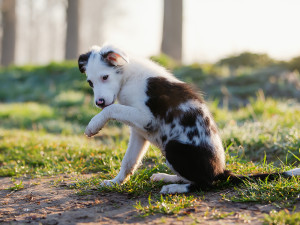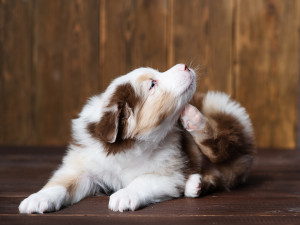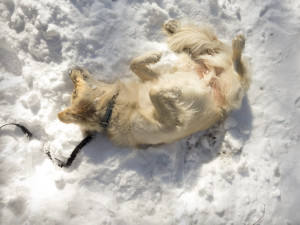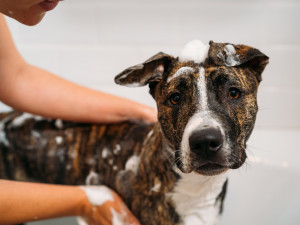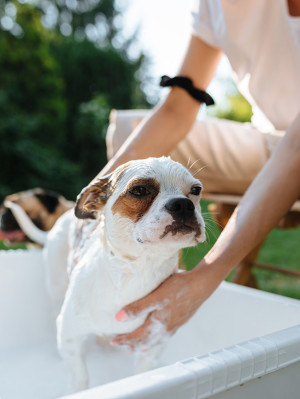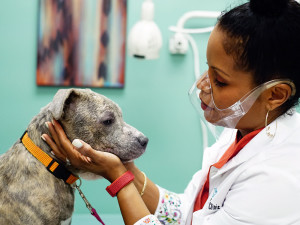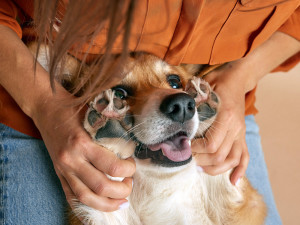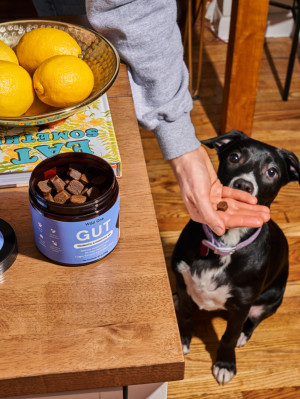Can Dogs Get Pimples? Causes, Symptoms, and Treatments
Time to go to the doggie dermatologist!
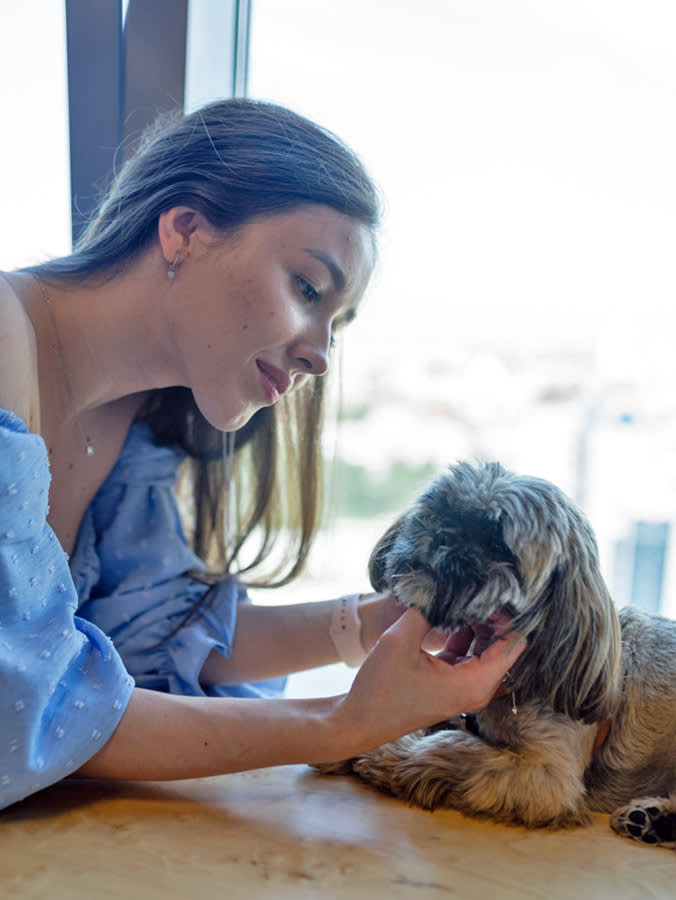
share article
In This Article:
Types of Canine Acne opens in a new tab Underlying Causes of Dog Pimplesopens in a new tab Diagnosing Dog Acneopens in a new tab How to Get Rid of Dog Pimplesopens in a new tab Preventing Future Breakouts opens in a new tab Frequently Asked Questionsopens in a new tab
Just like us, dogs can experience pimples. Acne flare-ups most often emerge on a dog’s chin, muzzle, or lips and can be triggered by irritants, allergies, or poor hygiene. Dog acne can be treated, but other skin conditions should be ruled out first.
Types of canine acne
Dogs can get pimples almost anywhere on their skin. Sometimes, physical exams (or thorough petting) reveal small pimples on the face, back, or even pimples in dog ears. Sometimes, dogs have pimples that are small and camouflaged by their fur. Some dogs have pimples that are hard to miss, especially on areas of the body where hair is scant. Acne can cause itching or discomfort, but some dogs don’t seem to be bothered by the bumps on their skin. Canine acne is more likely to develop in young dogs and dogs with short hair.
Canine acne is called folliculitis, which means inflammation of the hair follicle. Most commonly, dogs develop folliculitis on their lips, chin, or muzzle. Canine acne can manifest in many forms, including:
Papules
Papules are small (less than one centimeter), raised bumpsopens in a new tab on the skin that are usually reddish in color. They are the result of irritation and can be tender due to inflammation.
Pustules
Pustules are similar to papules in that they are small, red, raised bumps. But pustules are filled with pus. Pustules tend to develop when papules become infected with bacteria.
Comedones
Comedones develop when hair follicles get filled with skin cells and goop from the oil glands. Comedones are similar to blackheads in people.
Furunculosis
Folliculitis is any inflammation of the hair follicle. Furunculosis occurs when that inflammation is accompanied by infection and abscess formation.
Vesicles and bullae
Vesicles and bullae on dogs are large, fluid-filled blisters on the surface of the skin. These are not common and can be the result of auto-immune disorders.
Furunculosis
Folliculitis is any inflammation of the hair follicle. Furunculosis occurs when that inflammation is accompanied by infection and abscess formation.
Underlying causes of dog pimples
Dog pimples can be frustrating for both pups and their parents, especially if the cause is not obvious. Although the cause of of dog pimples is not always known, there are several common factors that can contribute to pimples erupting:
Skin trauma
Constant rubbing and scratching can lead to broken hairs and tiny cuts in the skin, creating an opportunity for hair follicles to get clogged or invaded by bacteria. Skin can become irritated if dogs constantly rub their faces on things like grass, indoor rugs, or plastic food bowls.
Allergies
Allergiesopens in a new tab can cause a dog’s skin to be red, itchy, and inflamed. Dogs can be allergic to certain proteins in their food or elements in their environment.
Hygiene
Dogs touch everything with their faces. Constant contact with dirty bowlsopens in a new tab, toys, and bedding can contribute to acne. Dogs that use plastic bowls may be more prone to acne. If not cleaned regularly, bacteria can live in the grooves and scratches of plastic dishes and get on a dog's skin during meal time. Elizabethan collars (or cones) can also trap in a lot of moisture and funk, increasing the risk for acne.
Genetics
Genetic factors can make some dogs more prone to getting acne. Breeds that are predisposed to pimples include Boxers, English Bulldogs, French Bulldogsopens in a new tab, Doberman Pinschers, and Rottweilers.
Immune disorders
A compromised immune system can affect the skin's ability to fight off infections, increasing the likelihood of pimples.
Diagnosing dog acne
When diagnosing acne in dogs, veterinarians will start with a medical history and physical exam. The most common places vets see pimples on dogs are on the lips, muzzle, and chin, but pimples can erupt in other parts of the body, and they can vary in severity. Because other skin issues can cause irritation and bumps on the skin, your vet may recommend doing some tests to rule out other issues like parasites, fungal infections, deep bacterial infections, and cancer. Tests may include skin scraping, bacterial or fungal culture, or skin biopsy.
How to get rid of dog pimples
Some dogs will experience a temporary breakout that doesn't require full-blown treatment, but other dogs can have chronic issues that make them miserable from itchingopens in a new tab and discomfort. Luckily, there are options for getting rid of dog pimples. Your veterinarian can guide you through the best course of action, but some common treatments include:
Topical medications
Your vet may recommend medicated ointments, shampoos, or wipes to help address your dog's acne. Depending on the active ingredients, these products can be used to address secondary bacterial infections or to gently exfoliate the top layer of skin. Pet parents should be aware that, just like with people, it's possible to over-exfoliate a dog's skin, causing more irritation and inflammation. So, consult your veterinarian before using any medicated products
Oral medications
Dogs with acne often develop secondary bacterial infections. Mild infections can often be addressed with topical medications, but more severe infections often require oral antibiotics. Dogs with severe inflammation associated with their acne may require steroids.
Diet change
Food allergies in dogs often manifest as skin irritation and inflammation, which can lead to pimples. If you or your vet are concerned about possible food allergies, a food trial and eventual diet change may be in order.
Regular cleaning
Regular cleaning of the affected skin (especially drooly chins and muzzles) can help get rid of acne. Be sure to clean or replace dirty toys, bedding, food and water dishes, or anything that regularly makes contact with your dog's skin.
Changing food/water bowls
A common theory is that the tiny grooves and scratches in plastic bowls can harbor microorganisms that eventually make their way into your dog’s skin. Ditch the plastic bowls and opt for glass or metal. Be sure to clean them regularly.
Avoiding pimple popping
Never pop your dog’s pimples. Popping your dog’s zits can increase the risk of infection, cause more inflammation, and cause pain. Plus, it’s rude.
Preventing future breakouts
Some dogs have acne breakouts and come out the other side with clear doggy skin. Other dogs will have zits long-term. Here are some things that dog parent can do to help prevent future breakouts:
Regular grooming: Maintain a regular grooming schedule to keep your dog’s skin clean
Facial care: If your dog is a messy eater or has a lot of facial folds, gently clean your dog’s chin and muzzle after meals to remove any food residue. This can be helpful for preventing dog pimples on the chin.
Avoid skin trauma: Steer your dog away from activities and behaviors that lead to excess friction on the skin like rubbing, scratching, and rooting around with their noses.
Avoid triggers: If your dog has underlying allergies, try to avoid things that will trigger an allergic response.
Replace plastic bowls: Serve food and water in bowls made of glass or metal.
Clean regularly: Clean everything that touches your dog’s face (bowls, toys, etc) regularly.
See a vet: Seek veterinary advice if your dog is constantly breaking out, especially if it’s making your dog itchy or uncomfortable. Your vet can help come up with a plan to give your pup some relief or refer you to a veterinary dermatologistopens in a new tab.
FAQs (People also ask):
What does dog acne look like?
Dog acne can look like raised bumps on the skin that may or may not be fluid-filled. They are often red due to underlying inflammation, though they can be dark like blackheads in people. Dog acneopens in a new tab most commonly occurs on the lips, muzzle, and chin.
What do allergy bumps look like?
Dogs with seasonal allergiesopens in a new tab may develop papules (small red bumps) on their skin when they encounter an allergen. Dogs having an acute allergic reaction may develop hives and wheals (raised areas of the skin that are red, soft, and itchy).
Does mange in dogs cause pimples?
Mange can cause pimples in dogs. Dogs with mangeopens in a new tab also tend to have hair loss and crusty skin lesions. There are two types of mange in dogs: sarcoptic and demodectic. Sarcoptic mange is contagious, while demodectic is generally not contagious.
References:
Muzzle Folliculitis and Furunculosis (Chin Acne, Muzzle Acne) in Dogsopens in a new tab
Macule, Papule, Pustule, Plaque: How to Tell the Difference and Why it Matters — New York Vet 2019

Dr. Alycia Washington, DVM, MS
Alycia Washington, DVM, is a small animal emergency veterinarian based in North Carolina. She works as a relief veterinarianopens in a new tab and provides services to numerous emergency and specialty hospitals. Dr. Washington is also a children’s book author and freelance writer with a focus on veterinary medicine. She has a special fondness for turtles, honey bees, and penguins — none of which she treats. In her free time, Dr. Washington enjoys travel, good food, and good enough coffee.
Related articles
![A dog getting a bath]() opens in a new tab
opens in a new tabHow Often Should You Wash Your Dog?
“If your dog is stinky or looks dirty, wash ’em!” Plus more pro tips from LA dog groomer Jess Rona.
![Little dog getting showered by his owner in the backyard.]() opens in a new tab
opens in a new tabHow to Treat Dog Skin Diseases at Home
And how you might safely give your pup immediate relief.
![Dr. Joya, a vet, wearing a clear plastic mask and holding a gray dog with mange's head in her hands in the vet office]() opens in a new tab
opens in a new tabDr. Joya Griffin Is Poppin’ Puppy Pimples on TV
The star of National Geographic’s Pop Goes the Vet on the understated specialty, reality TV, and finding fun in the gross.
![a Chihuahua dog licking their paw]() opens in a new tab
opens in a new tabWhy Is Your Dog Obsessed With Licking Their Paws?
Their toes might smell like Fritos, but there’s no way they taste that good.
- opens in a new tab
Why Do My Dog’s Paws Smell Like Fritos?
That familiar corn chip aroma may simply seem quirky, but don’t ignore it.
![Black dog sitting beneath a table being fed a Wild One GUT supplement]() opens in a new tab
opens in a new tabBest Probiotics for Dogs
Your pup should keep these in their medicine cabinet.
